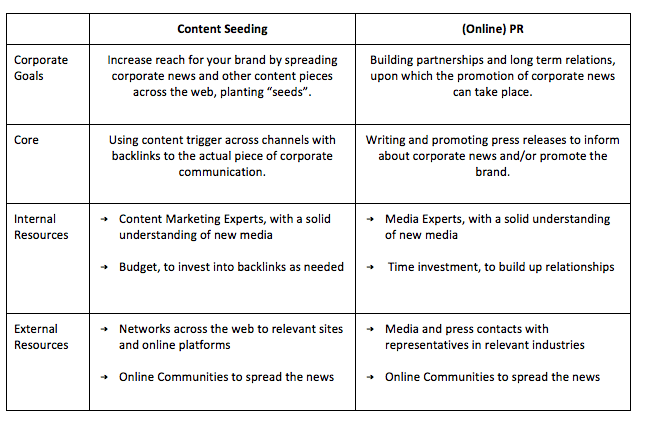How classical PR tries to define its new role in an era of increasing digitalization and consumer-driven media outlets
In an era of increasing digitalization, traditional PR has been called “dead” for quite some time now. As a result, companies are looking for an alternative technique to raise awareness for their brands. Recently the term “Content-Seeding” has been mentioned more and more frequently, in this context.
However, if you look closely, there are distinctive differences between the two practices, which agencies and companies alike should be aware of. This article will illustrate those differences, offering a basis for digital marketers to choose the most effective strategy for their business based on industry standards, individual goals and resources.
The PR-Dilemma
First things first. What exactly is the problem classical PR is currently facing? After all, the decreasing demand for print media (from the daily newspaper to magazines being replaced by E-versions) isn’t news. However, the extent of consequences this development leads to still is. As for the PR-industry there are three key developments any digital marketer should be aware of:
1. Diminishing reach of established media outlets
A decreasing demand in print media not only requires switching your advertising vehicles, but also your communication strategy as a whole. While it used to be a major achievement for brands to be published in (printed) newspapers or magazines, relevant for the respective target groups, nowadays the reach and therefore success or failure of these PR-methods are far more difficult to determine.
2. Reduced scalability of activities across channels
With a decreasing reach, print media become less and less scalable. A re-evaluation of your “traditional” media outlets is therefore essential to keep up with the digital transformation.
3. The rise of social
On top of the changing media outlets across target segments, many PR-agencies are still overwhelmed by the rising amount of social networks, as the former Social Media Manager of Zalando and founder of the PR-Agency Inspiragency, Larisse MacDonald, explains in our interview. A recent study about the usage of social media networks around the globe, confirmed the need for experienced Social Media Strategist in the PR-Business.
Given these critical developments, why hasn’t PR adjusted its focus sooner? The problem has been (and largely still is) that there are no clear guidelines on how to alter the existing industry to match new technology standards. At this point, it often seems to be a “trial-and-error” method, which agencies take on in an attempt to adjust to the new needs. As the Business Magazine Forbes puts it “there are some common trends in how successful organizations have adopted digital technologies, but no set of rules”.
It's in the name
So if there is no clear concept for the digital transformation of existing practices, why not choose a new concept with clear guidelines, measurable outcomes and established procedures as an alternative route?
Content-Seeding seems to offer such an alternative route. However, there are fundamental differences between the two strategies, which digital marketer should be aware of. The essence of those already lies in their names.
PR: it’s all about relations(hips)
PR, by definition, stands for Public Relations. PR professionals aim to build relationships with influencers and partners who help support the brands of their clients or company. This can take place online and offline. Online and offline PR follow the same process of promoting a piece of content across channels by using an established list of contacts (or selection of the same). While these business relations take a lot of time to develop, they are largely low in costs (an exception being the increase of reach for Online PR via Influencer Marketing).
Online PR itself is a rather new extension of the traditional PR. In an attempt to integrate the new media, agencies adjusted their portfolios by adding new services, such as Word-of-Mouth or Social Media Marketing. However, these PR-techniques are often still in their infancy. On the upside, the new channels allow PR professionals to determine clear KPIs, measure results and thus adjust their strategies, as needed, more quickly.
With the new Online PR replacing classical methods, the lines between Content-Seeding and PR became admittedly more blurry. However they are still there.
Content-Seeding: it’s all about reach
“PR is not just contacting journalists and influencers during working hours, it is a lifestyle. Both parties invest equal amounts in getting to know one another in order to build up relations with mutual benefits” (Larisse, MacDonald)
The key difference between Content Seeding and PR (both online and classical) is therewith already determined in its core. Content Seeding is less about long term relations but aiming to spread awareness for a brand as far as possible by planting “seeds” across the web. These “seeds” consist of little content pieces, aiming to trigger the interest of a pre-determined target group. Ultimately all seeds (aka content trigger) should link back to your main platform of corporate communication (which can be an article, a landing page or even the website itself).
In order to trigger the interest of their target groups, Content Seeding goes beyond press releases and written content to promote a brand. It focuses equally on the identification of platforms to plant content trigger strategically and spreading the same via shares from its audience. To achieve this balance, Content Seeding uses multimedia content across channels. The main goal is to create content which its target group doesn't only want to consume for informational purposes but also wants to share with its peers. As a result content trigger become shareable beyond the strategically predetermined touchpoints.
Depending on the site on which you are planting your seed, this process can be anything, from free to very costly. Therefore it is wise to evaluate the cost-benefit ratio ahead of time before starting any seeding campaign.
In a Nutshell
In sum new PR (or Online PR), manages to solve some of the issues of classical PR. The new media offer a better reach and are more scalable than print media nowadays. However one key issue remains: as the need to integrate social media and other new channels into the PR Strategy rises, so does the need for different qualifications and skills for PR professionals.
While agencies and companies alike have recognized the need to adapt cross media-strategies, the knowledge of professionals, as well as basic guidelines, to turn those new strategies into action haven´t been developed yet. This gap has been the reason for alternative routes, like Content Seeding, to appear. It's been seen as the solution to tackle all major problems of classical PR at once. Content Seeding is calculable, measurable and therefore scalable. It doesn't require a lot of time. Plus, professionals often have a background in Journalism or Content Marketing, which comes with a solid understanding of how to deal with new media.
In the light of these advantages, it seems like smart idea to use Content Seeding techniques as the “new PR”. However, Content Seeding has different goals than PR, hence it requires different skill-sets, resources and ultimately serves a different purpose, in a nutshell:

As for the question at hand, whether Content Seeding can be seen as the new PR or even as an alternative route to reach goals previously connected to PR activities, the answer is “no”. In order to find the best strategy for your business, be it Content-Seeding, Online PR or even a combination of the two, it is crucial to keep in mind the differences between the two methods in order to match your corporate KPIs as well as resources to them. Carefully analyse your resources, against your corporate goals and target group preferences. Only by looking at all of these factors you will be able to take your external communication efforts to the next level in todays consumer-driven media landscape.

Thanks to Hanna Oeljeschlaeger for sharing their advice and opinions in this post. Hanna started her career as a bilingual Journalist and Content Strategist in San Francisco, CA. Her work as a freelancer, allowed Hanna to combine her background in international marketing with her passion for tech and event journalism. As a native German, her current focus are the DACH and US markets. In April 2016 Hanna started as Content Marketing Manager at
Shore, a web-based software which helps local businesses adjust to an increasingly digitalized world..




 Thanks to Hanna Oeljeschlaeger for sharing their advice and opinions in this post. Hanna started her career as a bilingual Journalist and Content Strategist in San Francisco, CA. Her work as a freelancer, allowed Hanna to combine her background in international marketing with her passion for tech and event journalism. As a native German, her current focus are the DACH and US markets. In April 2016 Hanna started as Content Marketing Manager at
Thanks to Hanna Oeljeschlaeger for sharing their advice and opinions in this post. Hanna started her career as a bilingual Journalist and Content Strategist in San Francisco, CA. Her work as a freelancer, allowed Hanna to combine her background in international marketing with her passion for tech and event journalism. As a native German, her current focus are the DACH and US markets. In April 2016 Hanna started as Content Marketing Manager at 


